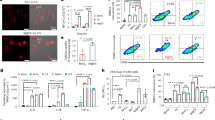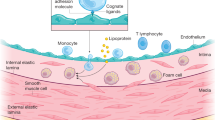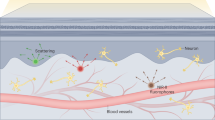Abstract
Sudden fibrous cap disruption of 'high-risk' atherosclerotic plaques can trigger the formation of an occlusive thrombus in coronary arteries, causing acute coronary syndromes. High-risk atherosclerotic plaques are characterized by their specific cellular and biological content (in particular, a high density of macrophages), rather than by their impact on the vessel lumen. Early identification of high-risk plaques may be useful for preventing ischemic events. One major hurdle in detecting high-risk atherosclerotic plaques in coronary arteries is the lack of an imaging modality that allows for the identification of atherosclerotic plaque composition with high spatial and temporal resolutions. Here we show that macrophages in atherosclerotic plaques of rabbits can be detected with a clinical X-ray computed tomography (CT) scanner after the intravenous injection of a contrast agent formed of iodinated nanoparticles dispersed with surfactant. This contrast agent may become an important adjunct to the clinical evaluation of coronary arteries with CT.
This is a preview of subscription content, access via your institution
Access options
Subscribe to this journal
Receive 12 print issues and online access
$209.00 per year
only $17.42 per issue
Buy this article
- Purchase on Springer Link
- Instant access to full article PDF
Prices may be subject to local taxes which are calculated during checkout




Similar content being viewed by others
References
Naghavi, M. et al. From vulnerable plaque to vulnerable patient: a call for new definitions and risk assessment strategies: part I. Circulation 108, 1664–1672 (2003).
Virmani, R., Burke, A.P., Farb, A. & Kolodgie, F.D. Pathology of the vulnerable plaque. J. Am. Coll. Cardiol. 47, C13–C18 (2006).
Libby, P. Current concepts of the pathogenesis of the acute coronary syndromes. Circulation 104, 365–372 (2001).
Fuster, V., Moreno, P.R., Fayad, Z.A., Corti, R. & Badimon, J.J. Atherothrombosis and high-risk plaque: part I: evolving concepts. J. Am. Coll. Cardiol. 46, 937–954 (2005).
Topol, E.J. & Nissen, S.E. Our preoccupation with coronary luminology. The dissociation between clinical and angiographic findings in ischemic heart disease. Circulation 92, 2333–2342 (1995).
Libby, P. Inflammation in atherosclerosis. Nature 420, 868–874 (2002).
Mauriello, A. et al. Diffuse and active inflammation occurs in both vulnerable and stable plaques of the entire coronary tree: a histopathologic study of patients dying of acute myocardial infarction. J. Am. Coll. Cardiol. 45, 1585–1593 (2005).
Fayad, Z.A. & Fuster, V. Clinical imaging of the high-risk or vulnerable atherosclerotic plaque. Circ. Res. 89, 305–316 (2001).
Hoffmann, U. et al. Predictive value of 16-slice multidetector spiral computed tomography to detect significant obstructive coronary artery disease in patients at high risk for coronary artery disease: patient-versus segment-based analysis. Circulation 110, 2638–2643 (2004).
Leber, A.W. et al. Quantification of obstructive and nonobstructive coronary lesions by 64-slice computed tomography: a comparative study with quantitative coronary angiography and intravascular ultrasound. J. Am. Coll. Cardiol. 46, 147–154 (2005).
Achenbach, S. et al. Detection of calcified and noncalcified coronary atherosclerotic plaque by contrast-enhanced, submillimeter multidetector spiral computed tomography: a segment-based comparison with intravascular ultrasound. Circulation 109, 14–17 (2004).
Leber, A.W. et al. Accuracy of 64-slice computed tomography to classify and quantify plaque volumes in the proximal coronary system: a comparative study using intravascular ultrasound. J. Am. Coll. Cardiol. 47, 672–677 (2006).
Viles-Gonzalez, J.F. et al. In vivo 16-slice, multidetector-row computed tomography for the assessment of experimental atherosclerosis: comparison with magnetic resonance imaging and histopathology. Circulation 110, 1467–1472 (2004).
Leber, A.W. et al. Accuracy of multidetector spiral computed tomography in identifying and differentiating the composition of coronary atherosclerotic plaques: a comparative study with intracoronary ultrasound. J. Am. Coll. Cardiol. 43, 1241–1247 (2004).
Schroeder, S. et al. Accuracy and reliability of quantitative measurements in coronary arteries by multi-slice computed tomography: experimental and initial clinical results. Clin. Radiol. 56, 466–474 (2001).
Pohle, K. et al. Characterization of non-calcified coronary atherosclerotic plaque by multi-detector row CT: comparison to IVUS. Atherosclerosis 190, 174–180 (2007).
Zhang, Z. et al. Non-invasive imaging of atherosclerotic plaque macrophage in a rabbit model with F-18 FDG PET: A histopathological correlation. BMC Nucl. Med. 6, 3 (2006).
Helft, G. et al. Progression and regression of atherosclerotic lesions: monitoring with serial noninvasive magnetic resonance imaging. Circulation 105, 993–998 (2002).
Aikawa, M. et al. Lipid lowering by diet reduces matrix metalloproteinase activity and increases collagen content of rabbit atheroma: a potential mechanism of lesion stabilization. Circulation 97, 2433–2444 (1998).
Ruehm, S.G., Corot, C., Vogt, P., Kolb, S. & Debatin, J.F. Magnetic resonance imaging of atherosclerotic plaque with ultrasmall superparamagnetic particles of iron oxide in hyperlipidemic rabbits. Circulation 103, 415–422 (2001).
Hyafil, F. et al. Ferumoxtran-10-enhanced MRI of the hypercholesterolemic rabbit aorta: relationship between signal loss and macrophage infiltration. Arterioscler. Thromb. Vasc. Biol. 26, 176–181 (2006).
Kooi, M.E. et al. Accumulation of ultrasmall superparamagnetic particles of iron oxide in human atherosclerotic plaques can be detected by in vivo magnetic resonance imaging. Circulation 107, 2453–2458 (2003).
Trivedi, R.A. et al. In vivo detection of macrophages in human carotid atheroma: temporal dependence of ultrasmall superparamagnetic particles of iron oxide-enhanced MRI. Stroke 35, 1631–1635 (2004).
Rudd, J.H. et al. Imaging atherosclerotic plaque inflammation with [18F]-fluorodeoxyglucose positron emission tomography. Circulation 105, 2708–2711 (2002).
Dunphy, M.P., Freiman, A., Larson, S.M. & Strauss, H.W. Association of vascular 18F-FDG uptake with vascular calcification. J. Nucl. Med. 46, 1278–1284 (2005).
Wisner, E.R. et al. Iodinated nanoparticles for indirect computed tomography lymphography of the craniocervical and thoracic lymph nodes in normal dogs. Acad. Radiol. 1, 377–384 (1994).
McIntire, G.L. et al. Time course of nodal enhancement with CT X-ray nanoparticle contrast agents: effect of particle size and chemical structure. Invest. Radiol. 35, 91–96 (2000).
Krause, W. Delivery of diagnostic agents in computed tomography. Adv. Drug Deliv. Rev. 37, 159–173 (1999).
Rabin, O., Manuel Perez, J., Grimm, J., Wojtkiewicz, G. & Weissleder, R. An X-ray computed tomography imaging agent based on long-circulating bismuth sulphide nanoparticles. Nat. Mater. 5, 118–122 (2006).
Mukundan, S., Jr. et al. A liposomal nanoscale contrast agent for preclinical CT in mice. AJR Am. J. Roentgenol. 186, 300–307 (2006).
Zheng, J., Perkins, G., Kirilova, A., Allen, C. & Jaffray, D.A. Multimodal contrast agent for combined computed tomography and magnetic resonance imaging applications. Invest. Radiol. 41, 339–348 (2006).
Fu, Y. et al. Dendritic iodinated contrast agents with PEG-cores for CT imaging: synthesis and preliminary characterization. Bioconjug. Chem. 17, 1043–1056 (2006).
Gupta, R. et al. Ultra-high resolution flat-panel volume CT: fundamental principles, design architecture, and system characterization. Eur. Radiol. 16, 1191–1205 (2006).
Flohr, T.G. et al. First performance evaluation of a dual-source CT (DSCT) system. Eur. Radiol. 16, 256–268 (2006).
Boll, D.T. et al. Spectral coronary multidetector computed tomography angiography: dual benefit by facilitating plaque characterization and enhancing lumen depiction. J. Comput. Assist. Tomogr. 30, 804–811 (2006).
Acknowledgements
We thank G. Cornily for her assistance with statistical analysis. This work was supported by grants from the Fédération Française de Cardiologie (F.H. and J.-C.C.) and from the US National Institutes of Health/National Heart, Lung and Blood Institute (R01 HL71021 and R01 HL78667 to Z.A.F.).
Author information
Authors and Affiliations
Contributions
F.H. and Z.A.F. conceived of and designed the project. F.H. and J.-C.C. performed the CT scans and the data analysis. J.E.F. performed the cell culture experiments. R.G. conducted the electron microscopy studies. E.V. performed the immunohistology studies. F.H., J.-C.C.,V.A., E.A.F., V.F., L.J.F. and Z.A.F. contributed to the writing of the manuscript. All authors discussed and commented on the manuscript.
Corresponding author
Ethics declarations
Competing interests
The authors declare no competing financial interests.
Supplementary information
Rights and permissions
About this article
Cite this article
Hyafil, F., Cornily, JC., Feig, J. et al. Noninvasive detection of macrophages using a nanoparticulate contrast agent for computed tomography. Nat Med 13, 636–641 (2007). https://doi.org/10.1038/nm1571
Received:
Accepted:
Published:
Issue Date:
DOI: https://doi.org/10.1038/nm1571
This article is cited by
-
Application of biomedical materials in the diagnosis and treatment of myocardial infarction
Journal of Nanobiotechnology (2023)
-
Control of the post-infarct immune microenvironment through biotherapeutic and biomaterial-based approaches
Drug Delivery and Translational Research (2023)
-
Integrating the second near-infrared fluorescence imaging with clinical techniques for multimodal cancer imaging by neodymium-doped gadolinium tungstate nanoparticles
Nano Research (2021)
-
Targeted therapy in chronic diseases using nanomaterial-based drug delivery vehicles
Signal Transduction and Targeted Therapy (2019)
-
Towards Quantification of Inflammation in Atherosclerotic Plaque in the Clinic – Characterization and Optimization of Fluorine-19 MRI in Mice at 3 T
Scientific Reports (2019)



